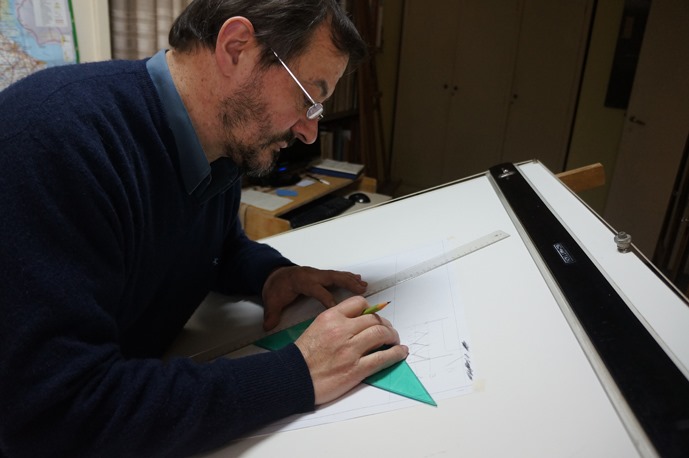Last June 2, checking if there were messages to answer on Facebook, I found the text of someone who gave the final farewell to Alejandro Eduardo Fadone. He dumbfounded me. I could not believe it. I searched if someone else was announcing Alejandro's last trip, but no, I didn't find any other messages at that time.
How is he going to die?! If he was full of dreams and projects; if he was in love with Chascomús, where he lived, in his small homeland by adoption. Finally, it was true. Surprising for me, because I did not have frequent contact with him, although we knew each other... and we had a pending discussion.
He died during heart surgery in the city of La Plata. Mónica Hoss de Lecomte, her last editor, wrote for the cover of Mapuche Symbology in Tehuelche territory –her book, my design stick-: “Since 1988, taking advantage of her 20-year experience as a graphic designer, she has dedicated herself to the systematic compilation of symbology of native peoples of Argentina. He began his work with the guidance of Mr. Guillermo E. Magrassi and received a scholarship from the National Endowment for the Arts in 1990. He based his research on direct work on the pieces, noticing the lack of aesthetic criteria used in most archaeological publications. (past and current) and other contemporaries of a diverse nature that draw on them, without addressing that basic problem that results in the misrepresentation of the original images.”
“He participated as a draftsman in archaeological campaigns -we continue with the quoted text- and relieved hundreds of pieces from public and private collections. His contact with the archaeological and ethnographic material led him to discover relationships and details of the aesthetics of these peoples, leading him to conclusions about the morphology of the designs. He presented papers at history and archeology conferences. From his research, he noted that historically little attention was paid to artists' conclusions about them years in the past and without acknowledging them”.
“Since then, he has tried to create a heuristic that allows the study of symbology, admitting it as a graphic piece, assuming that its intention is communicational, similar to that of a business logo or a road sign. It took as its starting point the theory unfolded by Ricardo Rojas (Silabario de la sonidoamericana, 1930) and the essay by Dr. Alberto Rex González (Arte, estructura y arqueología, 1974) trying to continue the systematization of data proposed by both authors, in search for the underlying ideas and beliefs in the symbolic languages embodied in objects.” These words synthesize the work and genius of a tireless researcher, who published several titles on pre-Columbian designs: Argentine indigenous design. An aesthetic approach to pre-Columbian iconography (as far as we know, six editions), 500 pre-Columbian designs from Argentina. Mythograms, and also Pre-Columbian Mandalas for coloring; all from La Marca editora. Finally, the result of his work in terms of textiles from the south: Mapuche Symbology in the Tehuelche Territory, by Maizal editions. The latter, a permanent reference work on my desk; a book that seduced me from the title. And by enjoying it, much more. Precisely, it was the subject of debate in our first personal meeting.
I told you before that we had a pending discussion. One time he came to visit us, Betty Taranto and me, during the course we were teaching on the upper floors of the Arandú saddlery, in the Buenos Aires neighborhood of Recoleta. On the work table, where the assistants supported their looms and their tools, was her book, my design cane. She took it in her hands, and when she opened it she had so much aim – good or bad; who knows - that she did it on a sheet where I had written, referring to a design called temu, "it's upside down". A debate began there about where the roots were represented and where the crown of this sacred tree for the Mapuches. After a while the conversation ended, politely, and with the respect we professed for each other, when I told him: -You can't imagine how much I would give so you could convince me with your reasons. We keep talking about other topics. The debate then continued epistolary.
The ponchos of San Martin and Las Heras. An outline of your authorship. Fadone opened the debate on the garment given to General San Martín and the studies to come, without a doubt, will be inspired by his observations. (Facebook photo by Alejandro Fadone)
In addition to his books, Fadone has done various works always related to his passion, indigenous design. Among others, he has left a very interesting study, and also disturbing, about the poncho that the Pehuenches gave to the Liberator. His work is called El poncho de luz del Gral. San Martín. History and symbology of this garment preserved in the National Historical Museum; where he affirms that it was erroneously considered a gift from the Pehuenches to San Martín, being in reality a strategy to carry out the crossing of the Andes. On this subject he has given a conference at the Pampean Museum of Chascomús, the preference adopted from him. The clarification of this question will be arduous, I do not doubt it. And rough too, because he dares to question a "revealed truth"; mythical, I would say. The spur is raised. If we dare to discuss it respectfully and sincerely, sure, El Poncho de San Martín is truly light.
We have lost a passionate researcher and disseminator of our cultural origins. A man who was not afraid of exposure or dissent, always supported by his convictions and his studies. When God decides, dear Alejandro Fadone, we will continue to enrich ourselves with our dispute. Anywhere. If it were in heaven, better.
* Special for Hilario. Arts Letters Crafts


